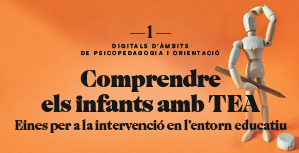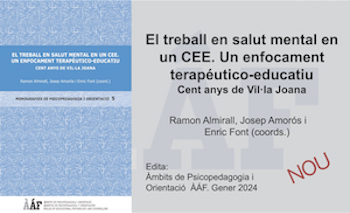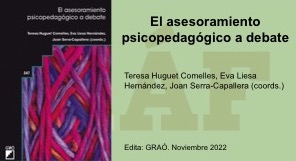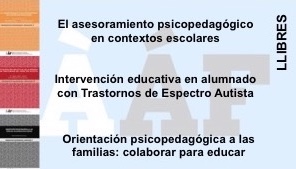Students with behavioural regulation difficulties: current status and challenges
DOI:
https://doi.org/10.32093/ambits.vi60504947Keywords:
Regulation difficulties, behaviour, childhood adversity, emotions, teacher-student relationship, educational network, discussion groups, affective human bonds, psycho-educational teamsAbstract
Behaviour regulation difficulties are an issue of concern for teachers. This is because of the complexity of the educational intervention. In this paper we attempt to explore its causes and origins to guide how to deal with it. We felt it was important to give a voice to professionals with extensive experience in dealing with these students: primary and secondary school teachers, educational counsellors from the Psychopedagogical Guidance Team (EAP) and professionals working at the Educational Resource Centre for Students with Developmental and Behavioural Disorders (CRETDIC). All of them took part in discussion groups and gave us their opinions. This helped us to better understand the challenges they face and to guide us in the care and counselling of these pupils.
From the results obtained, we highlight the need for spaces of accompaniment and reflection among teachers, creating teams that work together. It is a priority to encourage the expression and validation of the uncertainties that often arise when dealing with these pupils, to transform the emotions experienced by teachers, such as fear or anger, into an understanding, based on mentalisation, of the discomfort caused by dysregulated behaviour. In this sense, we emphasize the need to create bonds of trust between the teacher and the student as a basis for any intervention, although we note the difficulty that in order to achieve this bond it is necessary to create special conditions, since these bonds do not usually occur naturally.
References
Amorós, J. (2018). La conducta i els seus trastorns. Àmbits de Psicopedagogia i Orientació, 49, 31-41.
American Psychiatric Association. (2013). Diagnostic and statistical manual of mental disorders (5th ed.).
Balart, I., Sadurní, M., & Pérez-Burriel, M. (2021). Behaviour a regulation difficulties at primary and secondary school: risk and protection factors. Emotional and Behavioural Difficulties, 26 (3), 264-279.
Balart, I, Pérez-Burriel, M.&Sadurní Brugué, M. (2023) Giving voice to education professionals of primary and secondary school students with emotional and behavioural disorders: a qualitative study, European Journal of Special Needs Education, 38:5, 673-687.
Bateman, A., & Fonagy, P. (2016). Tratamiento basado en la mentalización para trastornos de la personalidad. Una guía práctica. Desclée de Brouwer.
Belsky, J.,& De Haan, M. (2011). Annual research review: parenting and children‟s brain development: the end of the beginning. Journal of Child Psychology and Psychiatry and Allied Disciplines, 52(4), 409–428.
Bolea, E.,& Gallardo, A. (2012). Alumnado con dificultades de regulación del Comportamiento. (Vol. II): Secundaria. Editorial Grao.
Bolea, E., (2016). La "PETITA XARXA": cooperar per a que els alumnes amb necessitats d'atenció en salut mental consentin vincular-se als ambients d'aprenentatge. Àmbits de Psicopedagogia i Orientació (44) 1-5
Bowlby, J. (1969). Attachment and loss: Vol 1. Attachment. Basic Books. Connor, D. F. (2002). Aggression and antisocial behavior in children andaAdolescents: research and treatment. Guilford Press.
Cyrulnik, B. (2017). Psicoterapia de la resiliencia: Hacia la reconstrucción de la esperanza. Herder Editorial.
Dong, M., Anda, R. F., Felitti, V. J., Dube, S. R., Williamson, D. F., Thompson, T. J., Loo, C. M.,&Giles, W. H. (2004). The interrelatedness of multiple forms of childhood abuse, neglect, and house hold dysfunction. Child Abuse & Neglect, 28(7), 771–784.
Felitti, V. J. (2002). The relation between adverse child hood experiences and adult health: turning gold into lead. The Permanente Journal, 6(1), 44–47.
Felitti, V. J., Anda, R.F., Nordenberg, D., Williamson, D. F., Spitz, A. M., Edwards,
V., Koss, M.P., & Marks, J.S. ( 1998) . Relationship of child hood abuse and house hold dysfunction to many of the leading causes of death in adults: the adverse child hood experiences (ACE) study. American Journal of Preventive Medicine, 14 (4), 245–258.
Finzi-Dottan, R., & Harel, G., (2014). Parents‟ potential for child abuse: an intergenerational perspective. Journal of Family Violence, 29 (4), 397-408.
Hamre, B. K., & Pianta, R. C. (2006). Student-Teacher Relations hips. In G. G. Bear & K. M. Minke (Eds.), Children's needs III: development, prevention, and intervention, 59–71. National Association of School Psychologists.
Henricsson, L., &Rydell, A. M. (2004). Elementary school children with behaviour problems: teacher-child relations and self-perception. A prospective study. Merrill- Palmer quarterly (Wayne State University. Press), 50(2), 111–138.
Mèlich, J. C., &Boixader, A. (2010). Els marges de la moral. Una mirada ètica a l'educació. Graó.
Montserrat, C., Casas, F., Muner, J., Vilarrubias, N., Pérez-Burriel. M,. & Sadurní, M. (2014). De les observacions als indicadors: el mòdul de suport ala gestió del risc en infància i adolescència (RUMI Infància Respon). Generalitat de Catalunya.
O'Connor, E. E., Collins, B. A.,&Supplee, L. (2012). Behavior problems in late child hood: the roles of early maternal attachment and teacher-child relationship trajectories. Attachment and Human Development, 14(3), 265-288.
Pajer, K., Stein, S., Tritt, K., Chang, C.-N., Wang, W., & Gardner, W. (2008) Conduct disorder in girls: neighbour hoods, family characteristics, and parenting behaviors. Child and Adolescent Psychiatry and Mental Health, 2(28), 1-11.
Pérez-Burriel, M. (2020). Apuntes Biográficos de John Bowlby (1907-1990), la revolución de la segunda mitad del siglo XX. In A. Taborda& E. Toranzo (Eds.),
Biografías: historia de relaciones significativas (Vol. 4, pp. 7–64). Nueva Editorial Universitaria. http://www.neu.unsl.edu.ar/wp-content/uploads/2020/04/BOWLBYY- FOUCAULT.pdf
Sadurní, M., & Rostan, C. (2004). La Importancia de las emociones en los períodos sensibles del desarrollo. Infancia y Aprendizaje, 27(1), 105–114.
Vega-Arce, M., & Nuñez-Ulloa, G. (2017). Experiencias adversas en la infancia: revisión de su impacto en niños de 0 A 5 años. Enfermería Universitaria, 14(2), 124–130.

Downloads
Published
Issue
Section
License
Copyright (c) 2024 montserrat solsona; Imma Balart, Marta Sadurní, Marc Pérez-Burriel

This work is licensed under a Creative Commons Attribution-NonCommercial-NoDerivatives 4.0 International License.
The authors maintain their copyright and give the right to the first publication of the work to the journal, registered under a Creative Commons Attribution-Non Commercial-NoDerivs license. This license allows others to download the works and to share them with others as long as they credit the author, but it does not allow for any kind of modification or commercial use.














